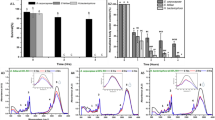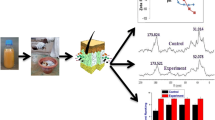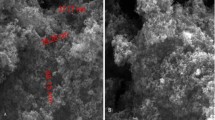Abstract
The surface properties of earthworms were studied using nitrogen adsorption/desorption isotherm and dynamic contact angle measurement with the aim to understand their non-stain behaviour. The results obtained by applying dynamic contact angle technique using water, glycerol, cooking oil and dimethylsilicone show that the surface properties of earthworms are a function of time. The critical surface energy, calculated using advancing angle, is as low as 11 × 10−3 J·m−2. However this hydrophobic behaviour at the initial contact moment changes progressively into hydrophilic as time goes by. This behaviour together with the creeping movement of corrugated surface is believed to be responsible for the non-stain behaviour of earthworms. The nitrogen adsorption isotherm of dried skin of earthworms at 77.3 K exhibits more or less Type V isotherm with surface area of 13 m2·g−1 calculated using the αs plot. The Type V isotherm is the indication of weak interaction between nitrogen and the worm surface.
Similar content being viewed by others
References
Hare E F, Shafrin E G, Zisman W A. Properties of films of adsorbed fluorinated acids. Journal of Physical Chemistry, 1954, 58, 236–239.
Savostianoff D, Dubos D. Compounds for Giving Fabrics Non-Stain Properties, US Patent 3996226, 1976.
Schondelmaier D, Cramm S, Klingeler R, Morenzin J, Zilkens Ch, Eberhardt W. Orientation and self-assembly of hydrophobic fluoroalkylsilanes. Langmuir, 2002, 18, 6242–6245.
Nakajima A, Abe K, Hashimoto K, Watanabe T. Preparation of hard super-hydrophobic films with visible light transmission. Thin Solid Films, 2000, 376, 140–143.
Jung D-H, Park I J, Choi Y K, Lee S-B, Park H S, Rühe J. Perfluorinated polymer monolayers on porous silica for materials with super liquid repellent properties. Langmuir, 2002, 18, 6133–6139.
Öner D, McCarthy T J. Ultrahydrophobic surfaces effects of topography length scales on wettability. Langmuir, 2000, 16, 7777–7782.
Minko S M, Müller M, Motornov M, Nitschke M, Grundke K, Stamm M. Two-level structured self-adaptive surfaces with reversibly tunable properties. Journal of American Chemical Society, 2003, 125, 3896–3900.
Mongillo J F. Nanotechnology 101, Greenwood Press, Westport, USA, 2007.
Ramaratnam K, Iyer S K, Kinnan M K, Chumanov G, Brown P J, Luzinov I. Ultrahydrophobic textiles using nanoparticles: Lotus approach. Journal of Engineered Fibers and Fabrics, 2008, 3, 1–14.
Lee H J. Design of artificial lotus leaves using nonwoven fabric. Journal of Materials Science, 2009, 44, 4645–4652.
Ren L Q, Tong J, Li J Q, Chen B C. Soil adhesion and biomimetics of soil-engaging components: A review. Journal of Agricultural Engineering Research, 2001, 79, 239–263.
Sun J R, Sun B N, Wei J H, Yang R F, Ren L Q, Cong Q, Chen B C. Measurement and determination of earthworm skin potential related to moving. Journal of Jilin University of Technology, 1991, 21, 18–22. (in Chinese)
Chen B C, Ren L Q, Li A Q, Hu Q X. Study on the method of collecting the body surface liquid of earthworms. Transactions of the Chinese Society of Agricultural Engineering, 1990, 6, 7–12. (in Chinese)
Yan Y Y, Zu Y Q, Ren L Q, Li J Q. Numerical modelling of electro-osmotically driven flow within the microthin liquid layer near an earthworm surface — a biomimetic approach. Proceedings of the Institution of Mechanical Engineers. Part C: Journal of Mechanical Engineering Science, 2007, 221, 1201–1210.
Zu Y Q, Yan Y Y. Numerical simulation of electroosmotic flow near earthworm surface. Journal of Bionic Engineering, 2006, 3, 179–186.
Gregg S J, Sing K S W. Adsorption, Surface Area and Porosity, 2nd ed, Academic Press, London, UK, 1982.
Zisman W A. Relation of the equilibrium contact angle to liquid and solid constitution. In: Gould R F ed, Advances in Chemistry, American Chemical Society, Washington DC, 1964, 43, 1–55.
Author information
Authors and Affiliations
Corresponding author
Rights and permissions
About this article
Cite this article
Gao, F., Baraka-Kamali, E., Shirtcliffe, N. et al. A preliminary study of the surface properties of earthworms and their relations to non-stain behaviour. J Bionic Eng 7, 13–18 (2010). https://doi.org/10.1016/S1672-6529(09)60193-1
Published:
Issue Date:
DOI: https://doi.org/10.1016/S1672-6529(09)60193-1




